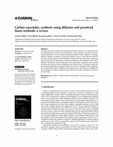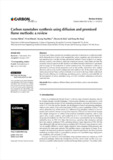

PARTNER
검증된 파트너 제휴사 자료
Carbon nanotubes synthesis using diffusion and premixed flame methods: a review
방대한 850만건의 자료 중 주제별로 만들수 있는 최적의 산출물을 해피 캠퍼스에서 체험 하세요 전문가의 지식과 인사이트를 활용하여 쉽고 폭넓게 이해하고 적용할수 있는 기회를 놓치지 마세요
10 페이지
최초등록일 2015.04.08
최종저작일
2015.03

-
 * 본 문서는 배포용으로 복사 및 편집이 불가합니다.
* 본 문서는 배포용으로 복사 및 편집이 불가합니다.
미리보기
서지정보
· 발행기관 : 한국탄소학회
· 수록지 정보 : Carbon Letters / 16권 / 1호
· 저자명 : Garima Mittal, Vivek Dhand, Kyong Yop Rhee, Hyeon-Ju Kim and Dong Ho Jung
목차
1. Introduction
2. Diffusion Flame Synthesis
3. Premixed Flame Synthesis
4. Conclusion
Acknowledgements
References
초록
In recent years, flame synthesis has absorbed a great deal of attention as a combustion methodfor the production of metal oxide nanoparticles, carbon nanotubes, and other related carbonnanostructures, over the existing conventional methods. Flame synthesis is an energyefficient,scalable, cost-effective, rapid and continuous process, where flame provides thenecessary chemical species for the nucleation of carbon structures (feed stock or precursor)and the energy for the production of carbon nanostructures. The production yield can beoptimized by altering various parameters such as fuel profile, equivalence ratio, catalystchemistry and structure, burner configuration and residence time. In the present report, diffusionand premixed flame synthesis methods are reviewed to develop a better understandingof factors affecting the morphology, positioning, purity, uniformity and scalability forthe development of carbon nanotubes along with their correlated carbonaceous derivativenanostructures.영어초록
In recent years, flame synthesis has absorbed a great deal of attention as a combustion method
for the production of metal oxide nanoparticles, carbon nanotubes, and other related carbon
nanostructures, over the existing conventional methods. Flame synthesis is an energyefficient,
scalable, cost-effective, rapid and continuous process, where flame provides the
necessary chemical species for the nucleation of carbon structures (feed stock or precursor)
and the energy for the production of carbon nanostructures. The production yield can be
optimized by altering various parameters such as fuel profile, equivalence ratio, catalyst
chemistry and structure, burner configuration and residence time. In the present report, diffusion
and premixed flame synthesis methods are reviewed to develop a better understanding
of factors affecting the morphology, positioning, purity, uniformity and scalability for
the development of carbon nanotubes along with their correlated carbonaceous derivative
nanostructures.참고자료
· 없음태그
-
자료후기
-
자주묻는질문의 답변을 확인해 주세요

꼭 알아주세요
-
본 학술논문은 (주)학지사와 각 학회간에 저작권계약이 체결된 것으로 AgentSoft가 제공 하고 있습니다.
본 저작물을 불법적으로 이용시는 법적인 제재가 가해질 수 있습니다. -
해피캠퍼스는 구매자와 판매자 모두가 만족하는 서비스가 되도록 노력하고 있으며, 아래의 4가지 자료환불 조건을 꼭 확인해주시기 바랍니다.
파일오류 중복자료 저작권 없음 설명과 실제 내용 불일치 파일의 다운로드가 제대로 되지 않거나 파일형식에 맞는 프로그램으로 정상 작동하지 않는 경우 다른 자료와 70% 이상 내용이 일치하는 경우 (중복임을 확인할 수 있는 근거 필요함) 인터넷의 다른 사이트, 연구기관, 학교, 서적 등의 자료를 도용한 경우 자료의 설명과 실제 자료의 내용이 일치하지 않는 경우
“Carbon Letters”의 다른 논문도 확인해 보세요!
-
Preparation and thermal properties of polyethylene-based carbonized fi.. 5 페이지
In this study, carbonized fibers were prepared by using acidically cross-linked LDPE fibers. The surface morphologies of the carbonized fibers were observed by SEM. The effects of cross-linking proces.. -
Influence of Nitrogen moieties on CO2 capture of Carbon Aerogel 5 페이지
Carbon aerogel is a porous carbon material possessing high porosity and high specific surfacearea. Nitrogen doping reduced the specific surface area and micropores, but it furnishedbasic sites to impr.. -
Conducting and interface characterization of carbonate-type organic el.. 6 페이지
Carbonate-type organic electrolytes were prepared using propylene carbonate (PC) and dimethylcarbonate (DMC) as a solvent, quaternary ammonium salts, and by adding differentcontents of 1-ethyl-3-methy.. -
CO2 adsorption characteristics of slit-pore shaped activated carbon pr.. 6 페이지
High crystallinity coke-based activated carbon (hc-AC) is prepared using a potassium hydroxidesolution to adsorb carbon dioxide (CO2). The CO2 adsorption characteristics of theprepared hc-AC are inves.. -
Preparation of sulfonated reduced graphene oxide by radiationinduced c.. 4 페이지
We report the preparation of sulfonated reduced graphene oxide (SRGO) by the sulfonationof graphene oxide followed by radiation-induced chemical reduction. Graphene oxideprepared by the well-known mod..
찾으시던 자료가 아닌가요?
지금 보는 자료와 연관되어 있어요!
문서 초안을 생성해주는 EasyAI



